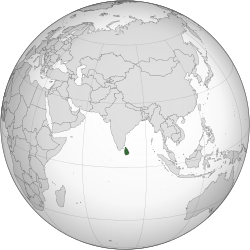British Settlements and Territories in the Island of Ceylon with its Dependencies (1802–1833) Island of Ceylon and its Territories and Dependencies (1833–1931) Island of Ceylon and its Dependencies (1931–1948) | |||||||||||||
|---|---|---|---|---|---|---|---|---|---|---|---|---|---|
| 1796–1948 | |||||||||||||
| Anthem: God Save the King (1796–1837; 1901–1948) God Save the Queen (1837–1901) | |||||||||||||
 | |||||||||||||
 British Ceylon map, published in Leipzig, c. 1914 | |||||||||||||
| Status |
| ||||||||||||
| Capital | Colombo | ||||||||||||
| Common languages | |||||||||||||
| Government | Monarchy | ||||||||||||
| Monarch | |||||||||||||
• 1815–1820 | George III (first) | ||||||||||||
• 1820–1830 | George IV | ||||||||||||
• 1830–1837 | William IV | ||||||||||||
• 1837–1901 | Victoria | ||||||||||||
• 1901–1910 | Edward VII | ||||||||||||
• 1910–1936 | George V | ||||||||||||
• 1936 | Edward VIII | ||||||||||||
• 1936–1948 | George VI (last) | ||||||||||||
| Governor | |||||||||||||
• 1798–1805 | Frederick North (first) | ||||||||||||
• 1944–1948 | Sir Henry Monck-Mason Moore (last) | ||||||||||||
| Prime Minister | |||||||||||||
• 1947–1948 | Don Stephen Senanayake | ||||||||||||
| Legislature |
| ||||||||||||
| Historical era | British Ceylon period | ||||||||||||
| 5 March 1796 | |||||||||||||
• Establishment of dual administration | 12 October 1798 | ||||||||||||
| 25 March 1802 | |||||||||||||
| 2 March 1815 | |||||||||||||
| 4 February 1948 | |||||||||||||
| Area | |||||||||||||
| 1946[1] | 65,993 km2 (25,480 sq mi) | ||||||||||||
| Population | |||||||||||||
• 1827[2] | 889,584[c] | ||||||||||||
• 1901[2] | 3,565,954 | ||||||||||||
• 1946[2] | 6,657,339 | ||||||||||||
| Currency |
| ||||||||||||
| |||||||||||||
| Today part of | Sri Lanka | ||||||||||||
| Historical states of Sri Lanka |
|---|
 |
British Ceylon (Sinhala: බ්රිතාන්ය ලංකාව, romanized: Britānya Laṃkāva; Tamil: பிரித்தானிய இலங்கை, romanized: Biritthāṉiya Ilaṅkai), officially British Settlements and Territories in the Island of Ceylon with its Dependencies from 1802 to 1833,[3] then the Island of Ceylon and its Territories and Dependencies from 1833 to 1931[4] and finally the Island of Ceylon and its Dependencies from 1931 to 1948,[5] was the British Crown colony of present-day Sri Lanka between 1796 and 4 February 1948. Initially, the area it covered did not include the Kingdom of Kandy, which was a protectorate,[citation needed] but from 1817 to 1948 the British possessions included the whole island of Ceylon, now the nation of Sri Lanka.
The British Ceylon period is the history of Sri Lanka between 1815 and 1948. It follows the fall of the Kandyan Kingdom into the hands of the British Empire.[6] It ended over 2300 years of Sinhalese monarchy rule on the island.[7] The British rule on the island lasted until 1948 when the country regained independence following the Sri Lankan independence movement.
Cite error: There are <ref group=lower-alpha> tags or {{efn}} templates on this page, but the references will not show without a {{reflist|group=lower-alpha}} template or {{notelist}} template (see the help page).
- ^ "The British Empire in 1924". The British Empire. Retrieved 7 November 2017.
- ^ a b c The Population of Sri Lanka (PDF). Population Growth: C.I.C.R.E.D. Series. 1974. pp. 3–4. Archived (PDF) from the original on 1 July 2014. Retrieved 2 August 2014.
- ^ "Sri Lanka". www.worldstatesmen.org. Retrieved 17 January 2023.
- ^ "Sri Lanka". www.worldstatesmen.org. Retrieved 17 January 2023.
- ^ "Sri Lanka". www.worldstatesmen.org. Retrieved 17 January 2023.
- ^ "King Sri wickrama rajasinghe: Sri Lanka's last monarch". August 2016. Retrieved 29 September 2019.
- ^ "The 1815 Kandyan Convention at the Audience Hall". Rootsweb.ancestry.com. Retrieved 8 October 2017.

